During the twenty-five minute drive to the lake, we saw many rice paddies and houses (new and old, occupied and abandoned) along the "new" road that floods every year, they hope this one lasts four years. The government is now paying the people who live there to move because it is cheaper to relocate them than fix the problems the floods create. Below is just over a minute of that drive. You'll hear a man speaking with a Cambodian-Australian accent, that is our guide for the evening. The other voices are friends who went with us to tour the lake and village. (They are talking about cricket catching in the countryside.)
Our guide said that the local people expect the floods and just rebuild their houses when it happens. The flood last year was the largest in a number of years and they expect a worse flood this year due to the current water levels. I am very curious what happens in the next few months given that it rains on average once a day now. If it doesn't rain for three days something doesn't feel right, but then it will rain two-three times a day for the next two-three days. When it is truly the rainy season, it will feel like it rains for days at a time.
When we arrived at the lake, we took a small, wooden boat with a rickety engine through the canal to see the Floating Village named Chong Khneas where nearly 1,115 families will eventually reside. Currently it is a canal, but in a few weeks it will be consumed by the rising waters of the lake, think about the numbers above. There is more than one Floating Village, but this one is the closest and most accessible for us.
We were in the blue boat second from the right at the dock
Once we left the dock we motored through the canal on the way to the open lake. We saw countless boats that were converted to houses where people live. Our guide said these are some of the poorest people in the country and they live here because there is no land to purchase hence there are no taxes to pay on any property they own. If they start to make money, they tend to build bars or shops on other boats so they can generate more income for their family. Many of the houses have electricity, shockingly, via car battery power. There is a fresh water station, a basketball court, two schools, and even a church in the village - all floating, of course. Under construction at the moment is a floating medical center, which is the nicest structure there, and it can help provide a better standard of living for the residents. Here are some photos of the people and houses in the Floating Village. (remember, you can click on the pictures to enlarge them)
other boats at the dock
passing boats as we leave the dock
heading out to the villages
two old women paddling their boat
a typical floating house
a woman cleaning vegetables in a small boat
a man paddling out to fish
two girls alone in a boat
a man net fishing
two women transporting vegetables
a young girl with a snake she wanted me to pet - I did, reluctantly
the same girl looking for another sucker
yes, that is a man in his drawers
a shop
the back of a Catholic school
the front of a school
a mother picking up her son from school
Recently, lower and middle schools were closed in Cambodia because of a virus that was mysteriously killing children. I doubt the schools in the pictures above closed - the students appeared to play more than study, which typifies the current state of Cambodian education.
a view of a family living in the floating village
a boy paddling in a bucket
there are kids with snakes everywhere
For the children of the Floating Villages, life has a sharp learning curve. Learning a skill to make your family money is imperative for the survival of the entire family. Everything from snake handling to helping dock boats while paddling in a tub are viable sources of income. These children are the future of Cambodia and should be doing more in life. No matter if the children live in the Floating Villages or are the children admitted to the school where I teach, struggle is simply a given in life. It is a very sad state of affairs.
a mobile store
a cat on a boat
this is possibly abandoned
a semi-aerial shot
the bees in the village are about the size of my thumb
a floating house
a fisherman returning home
a floating house with a small boat
some floating houses have very pretty plants growing on them
a cluster of floating houses
a view of Tonle Sap Lake from inside the boat - our final destination
Tonle Sap Lake - two small fishing boats in the distance
Below is a video that is fairly representative of what I saw while traveling through the floating village.
Next is a video of a kid jumping off our boat after jumping on to sell us some Angkor Lager and Coca-Cola.
This video is one of the first houses we saw when entering the Floating Village. This family has taken advantage of an old boat and converted it into a sizable fish trap attached to their house.
Visiting the Floating Village for an afternoon/evening was a very surreal experience. I felt like I was transported to another world, which it basically is for me. Knowing that the people living here move their houses, on average, twelve-fifteen times a year because of the rainy and dry seasons makes their living situation even more precarious. You see houses tied to trees so they can stay in one place longer. You see houses literally on top of fish traps. You see houses in various states of repair/decay. Most houses have what amounts to a dinghy for errands, and there is no thought of using a muffler even though most people seem to use converted car engines. Just like in the countryside, there is homemade fuel here as well.
Families seem very at home as you drive past their houseboats. Since we arrived in the later afternoon/early evening many families were eating dinner - you could smell the garlic and fish paste at times. Living in a Floating Village is a complete way of life for some people here. Since they are a fishing community, they move where they fish are because the fish are essential for their survival in many ways. I cannot really make heads or tails of the situation. I plan to visit again as the lake expands and I hope to gain a better idea of this aquanomadic lifestyle.
For more pictures and another take on this experience, visit my wife's blog at: http://comealongwithkathleenweil.blogspot.com










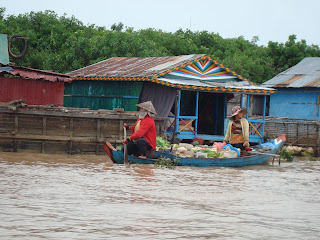
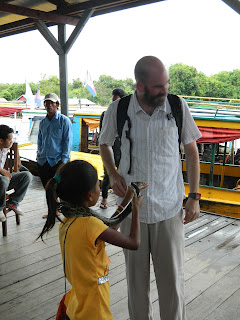
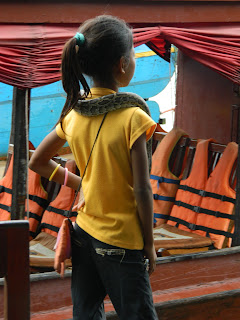








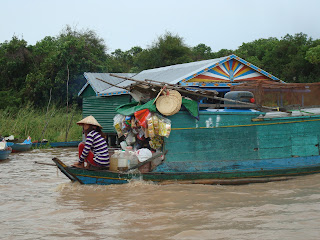

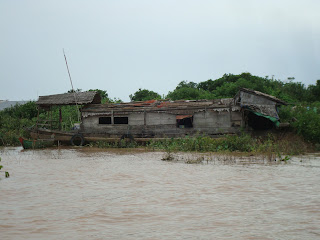






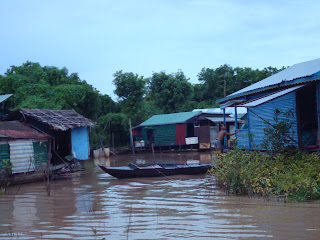


No comments:
Post a Comment